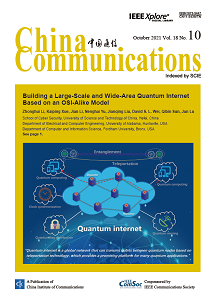认知网络中基于noma的混合频谱接入下行资源分配
IF 3.1
3区 计算机科学
Q2 TELECOMMUNICATIONS
引用次数: 0
摘要
为了解决有限的频谱资源与不断增长的通信需求之间的矛盾,提出了一种基于深度Q网络(Deep Q Network, DQN)的无线资源分配方案,对下行多用户认知无线电(CR)网络中的无线资源进行切片分配。辅助用户(su)使用非正交多址(NOMA)进行多路复用。单元采用混合频谱接入方式提高频谱效率(SE)。考虑到多种业务的需求,建立了增强型移动宽带(eMBB)切片和超可靠低延迟通信(URLLC)切片。该方案在保证用户服务质量(QoS)的同时,能最大限度地提高SE。本研究建立了CR-NOMA网络中资源分配与DQN算法之间的映射关系。该方案根据主用户(pu)的信噪比(SINR),输出最优的信道选择和功率分配。仿真结果表明,与Q-Learning方案相比,该方案具有更快的收敛速度和更高的奖励。此外,该方案比覆盖模式和仅覆盖模式都具有更好的SE。本文章由计算机程序翻译,如有差异,请以英文原文为准。
Downlink resource allocation for NOMA-based hybrid spectrum access in cognitive network
To solve the contradiction between limited spectrum resources and increasing communication demand, this paper proposes a wireless resource allocation scheme based on the Deep Q Network (DQN) to allocate radio resources in a downlink multi-user cognitive radio (CR) network with slicing. Secondary users (SUs) are multiplexed using non-orthogonal multiple access (NOMA). The SUs use the hybrid spectrum access mode to improve the spectral efficiency (SE). Considering the demand for multiple services, the enhanced mobile broadband (eMBB) slice and ultrareliable low-latency communication (URLLC) slice were established. The proposed scheme can maximize the SE while ensuring Quality of Service (QoS) for the users. This study established a mapping relationship between resource allocation and the DQN algorithm in the CR-NOMA network. According to the signal-to-interference-plus-noise ratio (SINR) of the primary users (PUs), the proposed scheme can output the optimal channel selection and power allocation. The simulation results reveal that the proposed scheme can converge faster and obtain higher rewards compared with the Q-Learning scheme. Additionally, the proposed scheme has better SE than both the overlay and underlay only modes.
求助全文
通过发布文献求助,成功后即可免费获取论文全文。
去求助
来源期刊

China Communications
工程技术-电信学
CiteScore
8.00
自引率
12.20%
发文量
2868
审稿时长
8.6 months
期刊介绍:
China Communications (ISSN 1673-5447) is an English-language monthly journal cosponsored by the China Institute of Communications (CIC) and IEEE Communications Society (IEEE ComSoc). It is aimed at readers in industry, universities, research and development organizations, and government agencies in the field of Information and Communications Technologies (ICTs) worldwide.
The journal's main objective is to promote academic exchange in the ICTs sector and publish high-quality papers to contribute to the global ICTs industry. It provides instant access to the latest articles and papers, presenting leading-edge research achievements, tutorial overviews, and descriptions of significant practical applications of technology.
China Communications has been indexed in SCIE (Science Citation Index-Expanded) since January 2007. Additionally, all articles have been available in the IEEE Xplore digital library since January 2013.
 求助内容:
求助内容: 应助结果提醒方式:
应助结果提醒方式:


